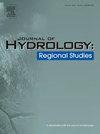An integrated hydrological model to simulate terrestrial water storage in a large river basin: Evaluation using GRACE data
IF 4.7
2区 地球科学
Q1 WATER RESOURCES
引用次数: 0
Abstract
Study region
Krishna River Basin, India
Study focus
Integrated hydrological models that simulate surface and subsurface processes, and their interactions in a single framework are essential for effective management of large-scale river basins. This research is aimed at developing an integrated hydrological model for the Krishna River Basin (KRB), India by tightly coupling a semi-distributed hydrological model (SWAT) with a fully distributed groundwater model (MODFLOW).
New hydrological insights for the region
For the first time, the coupled SWAT-MODFLOW model was applied to a large (>250,000 km2), conjunctively managed, complexly interacted river basin. SWAT simulated streamflows and evapotranspiration (ET) for the seven sub-basins agree with gauge flows (R: 0.45–0.85; NSE: 0.2–0.69) and MODIS-derived ET fluxes (R: 0.18–0.81; NSE: −3.18–0.66). However, MODFLOW simulated heads are in less agreement with observed groundwater levels (R: −0.6–0.6) due to spatial averaging. The coupled SWAT-MODFLOW is used to estimate terrestrial water storage anomalies (TWSA) at sub-basin level and validated with downscaled GRACE data at 0.25° resolution. Model performance is good for the lower reaches (NSE >0.3; R >0.65) with high flow exchanges and is low for the upper reaches due to underestimation of individual fluxes (NSE <0.3; R <0.65). We observed a basin-wide decline in TWSA during the simulation at a rate of 1.45 mm/month. Our findings can help in developing contextual plans for effective management of water resources.
模拟大流域陆地蓄水的综合水文模型:利用GRACE数据进行评价
模拟地表和地下过程的综合水文模型及其在单一框架内的相互作用对于有效管理大型河流流域至关重要。本研究旨在通过将半分布式水文模型(SWAT)与全分布式地下水模型(MODFLOW)紧密耦合,开发印度克里希纳河流域(KRB)的综合水文模型。首次将SWAT-MODFLOW耦合模型应用于一个大型(>250,000 km2)、联合管理、复杂相互作用的流域。SWAT模拟的7个子流域的径流和蒸散量(ET)与实测流量基本一致(R: 0.45-0.85;NSE: 0.2-0.69)和modis衍生的ET通量(R: 0.18-0.81;分析了无:−3.18 - -0.66)。然而,由于空间平均,MODFLOW模拟的水头与观测到的地下水水位(R:−0.6-0.6)不太一致。SWAT-MODFLOW耦合用于估算子流域水平的陆地储水异常(TWSA),并使用缩小比例的GRACE数据在0.25°分辨率下进行验证。模型在下游表现良好(NSE >0.3;R >0.65)为高流量交换,而由于对单个通量的低估,上游的R >; 0.3;R & lt; 0.65)。在模拟过程中,我们观察到整个流域的TWSA以1.45 毫米/月的速度下降。我们的研究结果可以帮助制定有效管理水资源的相关计划。
本文章由计算机程序翻译,如有差异,请以英文原文为准。
求助全文
约1分钟内获得全文
求助全文
来源期刊

Journal of Hydrology-Regional Studies
Earth and Planetary Sciences-Earth and Planetary Sciences (miscellaneous)
CiteScore
6.70
自引率
8.50%
发文量
284
审稿时长
60 days
期刊介绍:
Journal of Hydrology: Regional Studies publishes original research papers enhancing the science of hydrology and aiming at region-specific problems, past and future conditions, analysis, review and solutions. The journal particularly welcomes research papers that deliver new insights into region-specific hydrological processes and responses to changing conditions, as well as contributions that incorporate interdisciplinarity and translational science.
 求助内容:
求助内容: 应助结果提醒方式:
应助结果提醒方式:


